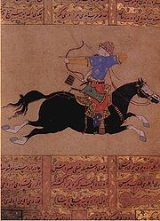
Sipahi
Encyclopedia
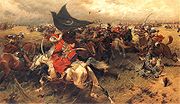
Cavalry
Cavalry or horsemen were soldiers or warriors who fought mounted on horseback. Cavalry were historically the third oldest and the most mobile of the combat arms...
corps. In the form of "Spahi" it was the title given to several cavalry units serving in the French and Italian colonial armies during the nineteenth and twentieth centuries.
The name ultimately derives from the Persian
Persian language
Persian is an Iranian language within the Indo-Iranian branch of the Indo-European languages. It is primarily spoken in Iran, Afghanistan, Tajikistan and countries which historically came under Persian influence...
(sepâh, meaning "army") and has the same root as the English term "sepoy
Sepoy
A sepoy was formerly the designation given to an Indian soldier in the service of a European power. In the modern Indian Army, Pakistan Army and Bangladesh Army it remains in use for the rank of private soldier.-Etymology and Historical usage:...
".
Description
Sipahi refers to all mounted troops other than akıncıAkinci
Akıncı were irregular light cavalry,scout divisions and advance troops of the Ottoman Empire's military. When the pre-existing Turkish ghazis were incorporated into the Ottoman Empire's military they became known as "akıncı." They were one of the first divisions to face the opposing military and...
s and tribal horsemen in Ottoman army. The word was used almost synonymously with cavalry. The sipahis formed two distinct types of cavalry: feudal-like, provincial timarlı sipahi (timariots) which consisted most of the Ottoman army, and salaried, regular kapıkulu sipahi (sipahi of the Porte), which consisted cavalry part of the Ottoman household troops.
Timarli Sipahis
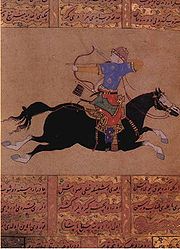
Timariot
A timariot was another name given to the Timarli Sipahi cavalry that served the Ottoman sultan and in return was granted a fief called a timar. The timariots had to assemble with the army when at war, and had to take care of the land entrusted to him in times of peace...
) was the holder of a fief
Fiefdom
A fee was the central element of feudalism and consisted of heritable lands granted under one of several varieties of feudal tenure by an overlord to a vassal who held it in fealty in return for a form of feudal allegiance and service, usually given by the...
of land ( tîmâr) granted directly by the Ottoman sultan
Sultan
Sultan is a title with several historical meanings. Originally, it was an Arabic language abstract noun meaning "strength", "authority", "rulership", and "dictatorship", derived from the masdar سلطة , meaning "authority" or "power". Later, it came to be used as the title of certain rulers who...
or with his official permission by beylerbey
Beylerbey
Beylerbey is the Ottoman and Safavid title used for the highest rank in the hierarchy of provincial administrators It is in western terms a Governor-general, with authority...
s. He was entitled to all of the income from that land, in return for military service. The peasants on the land were subsequently attached thereto. Timarli Sipahis' status resembled that of the knight
Knight
A knight was a member of a class of lower nobility in the High Middle Ages.By the Late Middle Ages, the rank had become associated with the ideals of chivalry, a code of conduct for the perfect courtly Christian warrior....
s of medieval Europe. Unlike medieval knights, they weren't legally owners of their fiefs. The right to govern and collect taxes in a timar fief was merely given to a Timarli Sipahi by Ottoman State. And in return, tımarli sipahis were responsible for security of the people in their timar, enlisting and training "jebelu" soldiers for the army.
A tîmâr was the smallest unit of land held by a Sipahi, providing a yearly revenue of no more than 20,000 akçe
Akçe
thumb|250px|AkçeA silver coin, the akçe was the chief monetary unit of the Ottoman Empire. The word "akçe" is derived from the Greek "" , the name of a Byzantine silver or billon coin, current in the region that eventually became the Ottoman Empire. The akçe is hence often called asper in English...
, which was between two and four times what a teacher earned. A ziamet
Ziamet
Ziamet was a form of land tenure in Ottoman Empire, consisting in grant of lands or revenues by the Ottoman Sultan to an individual in compensation for his services, especially military services. The ziamet system was introduced by Osman I who granted land tenure to his troops...
(زعامت) was a larger unit of land, yielding up to 100,000 akçe, and was owned by Sipahis of officer rank. A has (خاص) was the largest unit of land, giving revenues of more than 100,000 akçe, and was only held by the highest-ranking members of the military. A tîmâr Sipahi was obliged to provide the army with up to five retainers (jebelu), a ziamet Sipahi with up to twenty, and a has Sipahi with far more than twenty.
Jebelu means armed or armored, and those retainers (jebelu) expected to be mounted and fully equipped as Sipahi themselves. They were usually sons, brothers or nephews of the Sipahi and their position was probably more similar to squires than men at arms.
In contrast to Jannisaries
Janissary
The Janissaries were infantry units that formed the Ottoman sultan's household troops and bodyguards...
, Timarli Sipahis were always exclusively ethnic Turks. Provinces that did not have a Turkish population, like the Arabian peninsula, did not have timarli sipahis. Kanunname-i Sipahi (Book of law of Sipahis), that was written in Mehmed II era, clearly states that every sipahi (kapıkulu or timarli) must be of Turkish ancestry. It is thought that this was a way to control and to separate two fundamental army divisions (jannisary and sipahi) completely from each other and alienating Turks from capitol city politics while maintaining a controlled Turkish elite of bureaucracy and nobility in Anatolia and Balkans, without the danger of creating rival Turkish dynasties to the Ottoman throne(which was a central reason of destruction for earlier Turkish states). This way, jannisaries who controlled the central bureaucracy of the empire and had a lot of political influence, and sipahis who controlled the provincial bureaucracy and had the power of the army, would always have rivalry and never could cooperate against the House of Osman.
In wartime, Timarli sipahis and their jebelus (retainers) were gathered under their alay (regiment) bey
Bey
Bey is a title for chieftain, traditionally applied to the leaders of small tribal groups. Accoding to some sources, the word "Bey" is of Turkish language In historical accounts, many Turkish, other Turkic and Persian leaders are titled Bey, Beg, Bek, Bay, Baig or Beigh. They are all the same word...
s. Subsequently alay beys were gathered with their troops under sanjak
Sanjak
Sanjaks were administrative divisions of the Ottoman Empire. Sanjak, and the variant spellings sandjak, sanjaq, and sinjaq, are English transliterations of the Turkish word sancak, meaning district, banner, or flag...
(province) beys, and sanjak-bey
Sanjak-bey
Sanjak-bey, Sanjaq-bey or -beg was the Turkish title of the Bey in military and administrative command of a sanjak , answerable to a Wāli or other provincial governor. In a few cases the Sanjak-Bey was himself a governor directly answering to Istanbul....
s gathered under beylerbey
Beylerbey
Beylerbey is the Ottoman and Safavid title used for the highest rank in the hierarchy of provincial administrators It is in western terms a Governor-general, with authority...
s. If a battle was fought to be in Europe, Rumeli (Balkan) Sipahis took the honorary right flank of Ottoman Army under Rumeli beylerbey, while Anatolian beylerbey with his Sipahis took the left flank. If battle was in Asia, positions were switched. This way, classical period Ottoman army's both flanks wholly consisted of timariot cavalry, while janissary
Janissary
The Janissaries were infantry units that formed the Ottoman sultan's household troops and bodyguards...
infantry and artillery divisions consisted army's center.
Timarli Sipahis of Anatolia and Timarli Sipahis of Rumeli (Balkan) provinces had employed different equipments and tactics. Timarli Sipahis of Anatolia equipped and fought as classic horse archer style. They could shoot arrows back and forth while galloping. Yet they weren't nomadic cavalry and their status was similar to medium cavalry class. Balkan Timarli Sipahis donned chainmail, rode barded horses and carried lances. Though they also carried javelins as missile weapons to fend off chasing enemy cavalry, and fought as medium cavalry.
Timarli Sipahis of classical Ottoman period usually comprised the majority of the army and did the majority of the fighting on the battlefield. While infantry troops of the army's center maintained a static battle line, the cavalry flanks constituted its mobile hitting arm. During the battle, Timarli Sipahi tactics were used, opening the conflict with skirmishes and localized contacts with enemy cavalry. Regiments of Timarli Sipahis made charges against weaker or isolated units and whenever confronted with heavy cavalry, retreated back to main body of troops. During one regiment's retreat, other regiments of sipahis may have charged the chasing enemy's flanks. This way, they were trying to draw enemy cavalry away from infantry support, distort their cohesion, isolate and overwhelm them with numerical superiority. Anatolian Sipahis had the ability to harass and provoke opposing troops with arrow shots. More heavily equipped Balkan Sipahis were carried javelins for protection against closing enemy horsemen during their tactical retreats. This way, all cavalry flanks of Ottoman army fought a fluid, mounted warfare around center of the army which remained as a stable pivot.
Classical Ottoman period standard equipment of Rumeli (Balkan) Sipahis was round shield, lance, sword, javelins and plated chainmail. Their horses were barded. Standard equipment of Anatolian Sipahis at same era was round shield, composite Turkish bow
Turkish bow
The Turkish bow is a recurved composite bow used in the Ottoman Empire.The construction was that of the classic Asiatic composite bow, with a wooden core , animal horn on the side facing the archer, and sinew on the back. Animal glue held it together...
, arrows, kilij
Kilij
A kilij is a type of saber used by the Turks throughout history starting from late Hsiung-nu period to Avar Empire and Göktürk Khaganate, Uyghur Khaganate, Seljuk Empire, Timurid Empire, Mamluk Empire, Ottoman Empire, and later Turkic Khanates of Central Asia...
(turkish sword) and leather or felt armor. Beside of those, Sipahis of both provinces equipped with bozdogan and şeşper maces, and aydogan, teber and sagir axes. Anatolian Sipahis sometimes also carried lances.
Kapikulu Sipahis
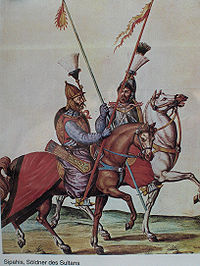
Janissary
The Janissaries were infantry units that formed the Ottoman sultan's household troops and bodyguards...
household infantry force. There was six divisions of Kapikulu Sipahis: The Sipahis, Silahtars, Right Ulufecis, Left Ulufecis, Right Garips and Left Garips. All of them got paid with quarterly salaries. The Sipahis and Silahtars were élite units within the six divisions.
Silahtars (which means weaponmasters) were chosen among the best warriors in Ottoman Empire. Any Ottoman soldier committed a significant deed in battlefield may have been promoted to Silahtar division. Although usually members of other mounted units, like Timarli Sipahis or other less prestigious four divisions of Kapikulu Sipahis promoted this way. Infantry soldiers had to enlist as serdengecti
Serdengecti
Serdengecti is a military term used in ottoman army. It is not a military class but a title which is given to the soldiers who do heroic acts in the battlefield like assaulting heavily fortified positions, which are ending generally with death of assaulters....
(literally means giver of his head) and survive suicide missions to join Silahtar division. If a janissary ever became a silahtar, other members of division with cavalry background despised him and former comrade janissaries considered him as traitor, but because the position and wealth of a silahtar was so attractive, janissaries and other soldiers still enlisted for suicide missions.
Commander of the Silahtar division was the Silahtar Agha. He was official weaponmaster of the palace and close personal aide of the sultan, who helps him to don his armor. He also was liaison officer who supervises the communication between the sultan and the Grand Vizier
Grand Vizier
Grand Vizier, in Turkish Vezir-i Azam or Sadr-ı Azam , deriving from the Arabic word vizier , was the greatest minister of the Sultan, with absolute power of attorney and, in principle, dismissable only by the Sultan himself...
.
The Sipahi division was the most prestigious of six divisions. Traditionally, sons of Ottoman élite (sons of Vezirs, Pashas and Beys) were served in this unit. The Sipahis and Silahtars were granted timar fiefs near Istanbul, alongside their salaries. Ulufeci means salaried ones and members of two Ulufeci divisions wasn't granted with timar fiefs. Garip means poor ones because their equipment was lighter compared to other four divisions. They were also getting their payments as salaries.
Six divisions of Sipahis were Kapikulu cavalry as the way Janissaries were Kapikulu infantry. Kapikulu means servant of the Porte. Servant of the Porte (Kapikullari) were legally servants of Ottoman throne. They weren't literally slaves, though their legal status was different than other ottoman people. The Sultan had power to directly command execution of his servants without any court verdict. On theory, Sultan hadn't this kind of power over other people, even simple peasants. If a freeman was promoted to one of Kapikulu Sipahi divisions, he considered automatically switched to kul (servant) status.
Equipment of Silahtar, Sipahi and Ulufeci divisions was plated mail
Plated mail
Plated mail is a type of mail with embedded plates. Armour of this type has been used in the Middle East, Japan, China, Korea, Central Asia, Greater Iran, India, Eastern Europe, and by the Moors.-Types of plated mail:In Russia there are three known varieties of this armour...
, chainmail, round shield, sword
Kilij
A kilij is a type of saber used by the Turks throughout history starting from late Hsiung-nu period to Avar Empire and Göktürk Khaganate, Uyghur Khaganate, Seljuk Empire, Timurid Empire, Mamluk Empire, Ottoman Empire, and later Turkic Khanates of Central Asia...
, composite bow, arrows, lance, bozdogan mace and axe. Their equipment was similar to Rumeli (Balkan) provincial Timarli Sipahis, though they wore brilliant fabrics, prominent hats and bore ornamented polearms. Two Garip divisions was more lightly equipped.
In classical period Ottoman battle formation, Kapikulu Sipahis were positioned back of the army as rearguards. They acted as reserve cavalry and bodyguards of Ottoman sultan and vezirs. Their job included to join and reinforce Ottoman army's flanks which otherwise consisted entirely provincial timariot sipahis.
The Sipahis of the Porte (Kapikulu Sipahis) were originally founded during the reign of Murad I
Murad I
Murad I was the Sultan of the Ottoman Empire, from 1361 to 1389...
. Although the Sipahis of the Porte were originally recruited, like the Janissaries
Janissary
The Janissaries were infantry units that formed the Ottoman sultan's household troops and bodyguards...
, using the devshirmeh
Devshirmeh
Devshirme was the practice by which...
system, by the time of Sultan Mehmed II
Mehmed II
Mehmed II , was Sultan of the Ottoman Empire for a short time from 1444 to September 1446, and later from...
, their ranks were only chosen from among the ethnic Turks who owned land within imperial borders. The Sipahi eventually became the largest of the six divisions of the Ottoman cavalry. The duties of the Sipahis included riding with the sultan on parades and as a mounted bodyguard. Earlier times Silahtar division was accompanied sultan on parades, though The Sipahi division took their place because sons of Ottoman "aristocracy" exclusively joined this regiment. In times of peace, they were also responsible for the collection of taxes. The Sipahis, however, should not be confused with the Timariots, who were irregular
Irregular military
Irregular military refers to any non-standard military. Being defined by exclusion, there is significant variance in what comes under the term. It can refer to the type of military organization, or to the type of tactics used....
cavalry organised along feudal lines and known as "sipahi"s colloquially. In fact, the two formations had very little in common.
Rivalry with the Janissary Corps
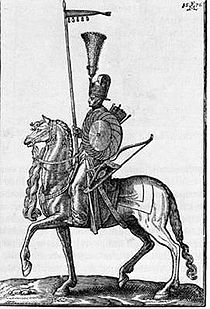
Whereas the Sipahis (both Tımarlı and Kapıkulu) were almost exclusively chosen amongst ethnic Turkic landowners, they made great strides of efforts to gain respect within the Ottoman Empire and their political reputation depended on the mistakes of the Janissary. That minor quarrels erupted between the two units is made evident with a Turkmen adage, still used today within Turkey, "Atlı er başkaldırmaz", which, referring to the unruly Janissaries, translates into, "Horsemen don't mutiny".
Towards the middle of the 16th century, the Janissaries had started to gain more importance in the army, though the Sipahis remained an important factor in the empire's bureaucracy, economy and politics, and a crucial aspect of disciplined leadership within the army. As late as the 17th century, the Sipahis were, together with their rivals the Janissaries, the de facto
De facto
De facto is a Latin expression that means "concerning fact." In law, it often means "in practice but not necessarily ordained by law" or "in practice or actuality, but not officially established." It is commonly used in contrast to de jure when referring to matters of law, governance, or...
rulers in the early years of sultan Murad IV
Murad IV
Murad IV Ghazi was the Sultan of the Ottoman Empire from 1623 to 1640, known both for restoring the authority of the state and for the brutality of his methods...
's reign. In 1826, after an evident Janissary revolt the Sipahis played an important part in the disbandment of the Janissary corps
The Auspicious Incident
The Auspicious Incident was the forced disbandment of the centuries-old Janissary corps by Ottoman sultan Mahmud II in June 1826....
. The Sultan received critical assistance from the loyalist Sipahi cavalry in order to forcefully dismiss the infuriated Janissaries.
Two years later, however, they shared a similar fate when Sultan Mahmud II
Mahmud II
Mahmud II was the 30th Sultan of the Ottoman Empire from 1808 until his death in 1839. He was born in the Topkapi Palace, Istanbul, the son of Sultan Abdulhamid I...
revoked their privileges and dismissed them in favor of a more modern military structure. Unlike the Janissaries before them they retired honorably, peacefully, and without bloodshed into new Ottoman cavalry divisions who followed modern military tradition
Military tradition
Military tradition is the specific set of practices associated with the military or soldiers in general. The concept may describe the styles of military uniform, drill, or even the music of a military unit.-In the United States:...
doctrines. Older sipahis were allowed to retire and keep their tımar lands until they die, and younger sipahis joined the Asakir-i Mansure-i Muhammediye army as cavalry.
Appearances in modern media
- Sipahis appear in The Creative Assembly'sCreative AssemblyThe Creative Assembly is a British video game developer established in 1987 by Tim Ansell and based in the West Sussex town of Horsham. An Australian branch is also operated from Fortitude Valley, Queensland...
Empire: Total War as a heavy cavalry unit employed by the Ottoman EmpireOttoman EmpireThe Ottoman EmpireIt was usually referred to as the "Ottoman Empire", the "Turkish Empire", the "Ottoman Caliphate" or more commonly "Turkey" by its contemporaries...
and other Islamic factions. They also are employed by the Hindu Marathas - Sipahis appear in Ensemble Studio'sEnsemble StudiosEnsemble Studios was a video game developer initially established in 1995 as an independent company, but was owned by Microsoft from 2001 to 2009, when it was officially disbanded. Ensemble developed many real-time strategy games, including the Age of Empires game series, Age of Mythology, and Halo...
Age of Empires IIIAge of Empires IIIAge of Empires III is a real-time strategy game developed by Microsoft Corporation's Ensemble Studios and published by Microsoft Game Studios. The Mac version was ported over and developed by Destineer's MacSoft Games and published by Destineer and MacSoft Games...
as a heavy cavalry unit unique to the Ottoman EmpireOttoman EmpireThe Ottoman EmpireIt was usually referred to as the "Ottoman Empire", the "Turkish Empire", the "Ottoman Caliphate" or more commonly "Turkey" by its contemporaries...
. - Sipahis are employed by the TurksOttoman EmpireThe Ottoman EmpireIt was usually referred to as the "Ottoman Empire", the "Turkish Empire", the "Ottoman Caliphate" or more commonly "Turkey" by its contemporaries...
in Medieval II Total War in three different forms: Sipahis, mounted archers; Sipahi Lancers, heavy cavalry, and Dismounted Sipahi Lancers, heavy infantry. - The Sipahi is the unique unit for the Ottoman EmpireOttoman EmpireThe Ottoman EmpireIt was usually referred to as the "Ottoman Empire", the "Turkish Empire", the "Ottoman Caliphate" or more commonly "Turkey" by its contemporaries...
in the computer games Civilization IIICivilization IIISid Meier's Civilization III, commonly shortened to Civ III or Civ 3, is the third installment of the Sid Meier's Civilization turn-based strategy computer game series. It was preceded by Civilization II and followed by Civilization IV. The game offers very sophisticated gameplay in terms of both...
and Civilization VCivilization VSid Meier's Civilization V is a turn-based strategy, 4X computer game developed by Firaxis, released on Microsoft Windows in September 2010 and on Mac OS X on November 23, 2010...
(where the game itself was made by Firaxis), the other unique unit is JanissaryJanissaryThe Janissaries were infantry units that formed the Ottoman sultan's household troops and bodyguards...
. - The mercenaries in William Barton's novel When Heaven FellWhen Heaven FellWhen Heaven Fell is a 1995 military science fiction novel by William Barton.Human mercenary Athol Morrison returns to Earth after serving in the legions of the Master Race...
are referred to as "Spahi." (Their ranks seem to use names from the Indian or Pakistani military.) - The Spahis are mentioned in the book The Count of Monte Cristo by Alexandre Dumas.
- A Sipahi Jawshan is an armor set in Final Fantasy XIFinal Fantasy XI, also known as Final Fantasy XI Online, is a MMORPG developed and published by Square as part of the Final Fantasy series. It was released in Japan on Sony's PlayStation 2 on May 16, 2002, and was released for Microsoft's Windows-based personal computers in November 2002...
.

